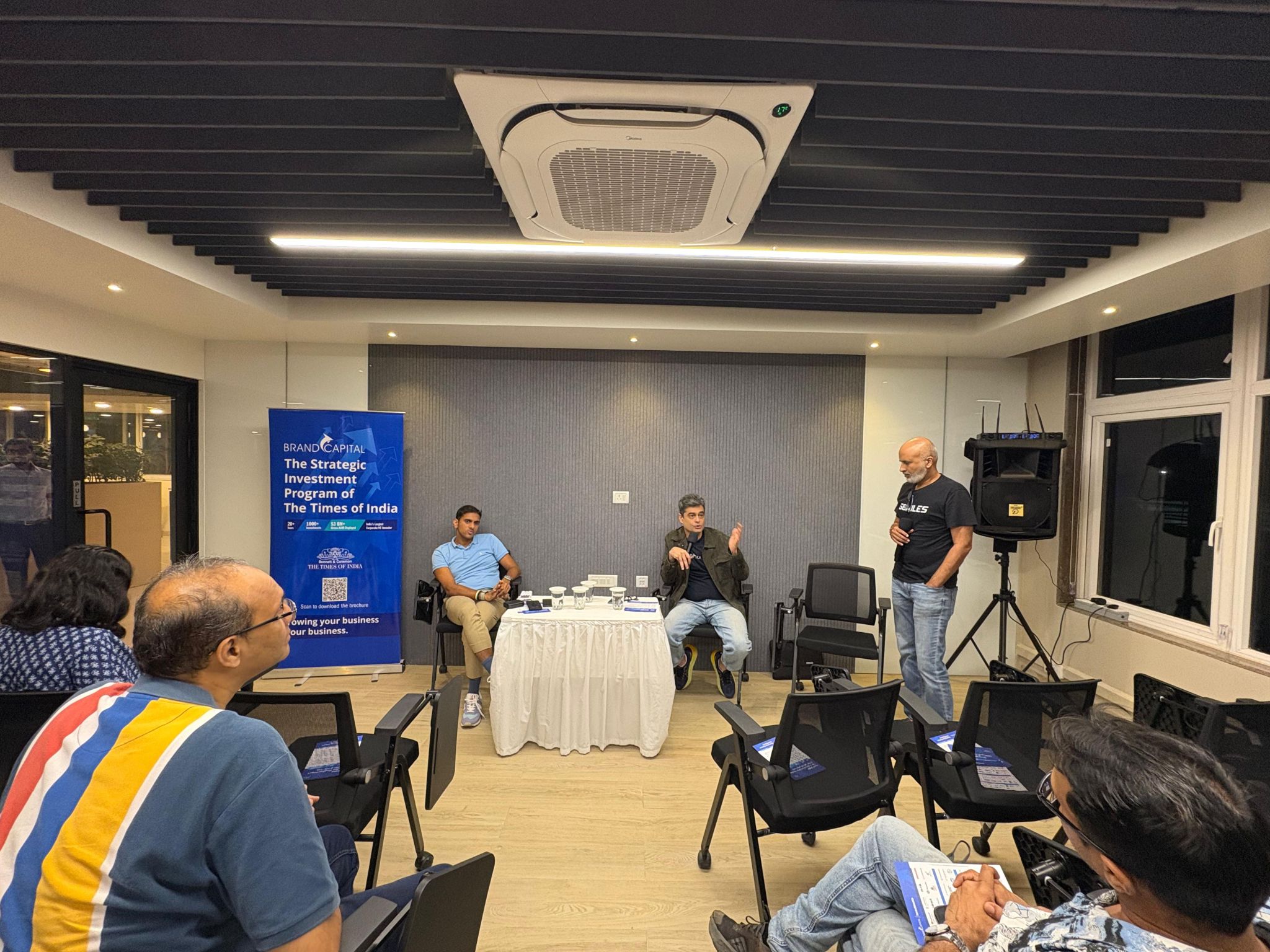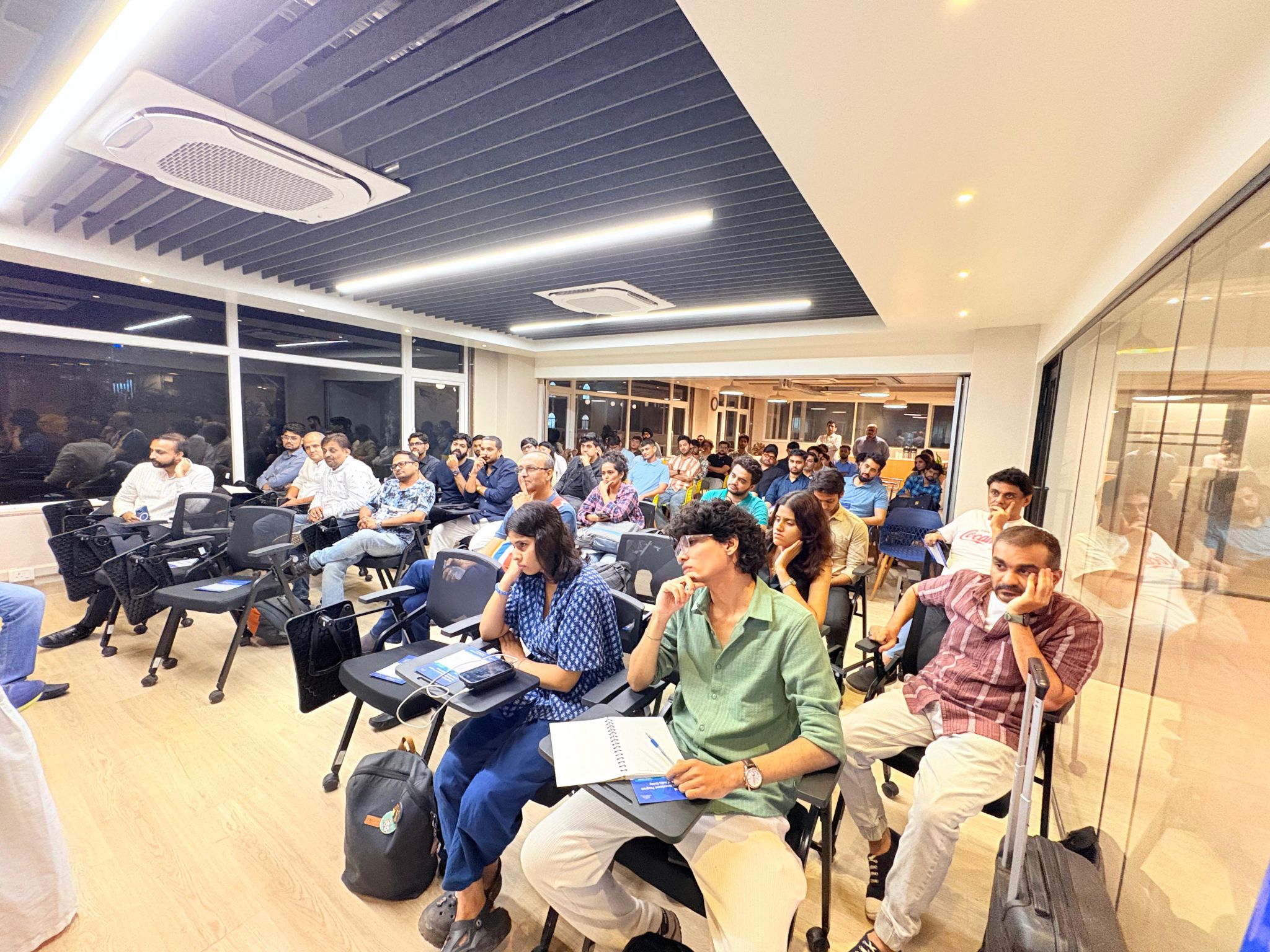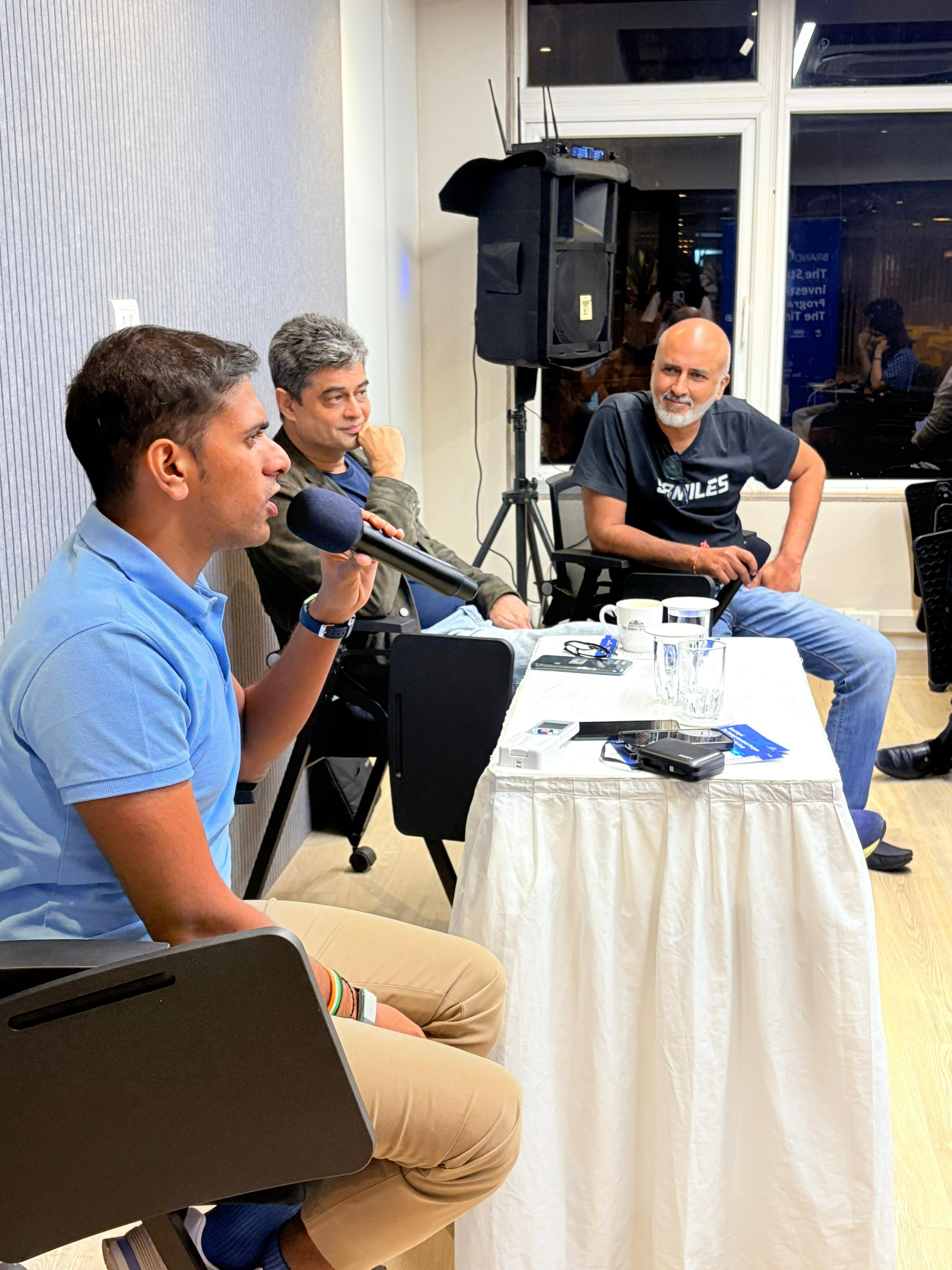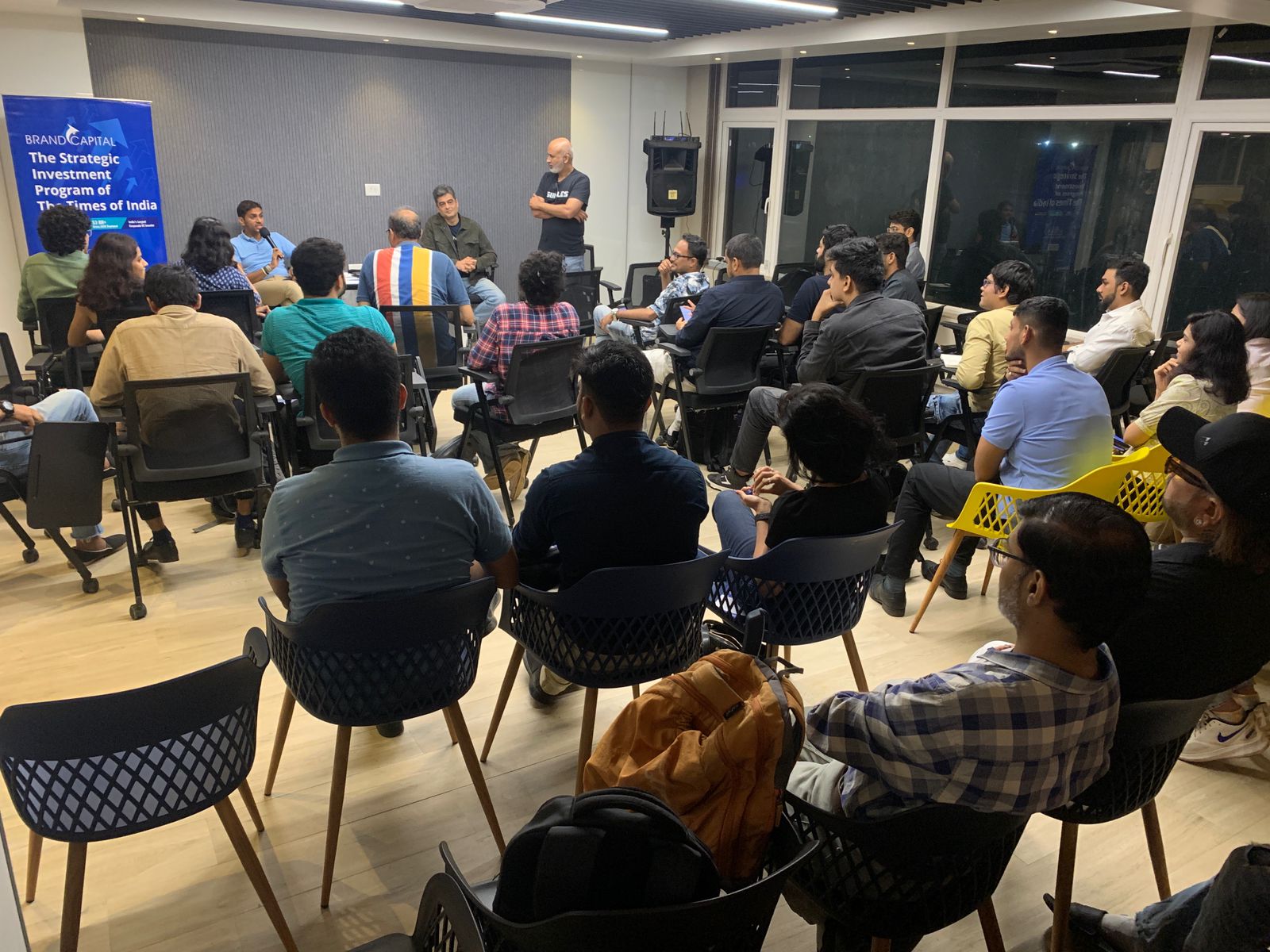Blessing in disguise
Books for Entrepreneurs
Documentary
eChai Wall of Love
How I Met My Co-Founder
In Focus Today
Insight Reports
Movies for Entrepreneurs
Notes from Podcasts
Slice of Startup Life
The First Hire
The First Welcome in Silicon Valley
The Reading Room
Unforgettable Lessons
Unlearning Is Often the Hardest Part of Growth

September 17th was about celebration. Jatin Chaudhary, co-founder of eChai, and I were in Mumbai with a few friends from the community for the DevX IPO listing. It felt like one of those moments that belonged to more than just a company. For many of us, it was a milestone for the larger ecosystem.
The very next evening the setting shifted to the Times of India building in Fort, where eChai and Brand Capital were hosting a session on how founders are building and scaling consumer brands. Jatin was supposed to moderate, but he had to return to Ahmedabad same day, and he asked me to step in. That is how I found myself on stage with leading d2c investor and founder, Arjun Vaidya and Abhishek Daga.
Arjun built Dr. Vaidya’s into one of India’s most recognizable Ayurvedic D2C brands and now co-leads V3 Ventures. When I asked how his perspective had changed, he said, “What I thought was right as a founder isn’t always right as an investor.” It was a simple line, but it stayed with me.
Abhishek spoke about building Nasher Miles into a ₹100 crore luggage brand while staying profitable. He talked about the risks of relying too much on Meta ads, the differences between online and offline pricing, and the advantage of being early on marketplaces. At one point he said, “An advantage is an advantage. Don’t debate it, use it.”
The audience added its own depth. Founders asked questions about logistics, supply chains, last-mile delivery, and how to balance burn with profit. These were not abstract discussions. They came from people who had already tested the easy answers and were now searching for new ones.
For me, the evening tied back to my own journey. Before 58Miles, I came from traditional corporate apparel. That world moved differently. Scale came from supply relationships, offline networks, and operational depth. When I stepped into the world of new-age D2C brands, I realised how much of that experience I had to unlearn. Not everything translates. Some parts of that background help, the discipline of operations, the patience for supply chains, but other instincts can hold you back. The challenge is knowing which lessons to carry forward and which ones to leave behind.
That night in Fort reminded me again that unlearning is often the hardest part of growth. It is not always visible and it is not celebrated, but it shapes the way founders move forward.
In Focus Today: Emergent Labs Lands $23M as Its Vibe-Coding Platform Crosses a Million Builders in 3 Months

Emergent Labs, co-founded by Mukund Jha (earlier of Dunzo) and Madhav Jha, has quickly become a platform for building AI-powered apps at speed. In just three months since launch, it reports more than a million builders, over 1.5 million apps created across 180 countries, and $15 million in recurring revenue. The idea is straightforward: help anyone move from an idea to production-ready software without long build cycles.
On September 24, Emergent announced a $23 million Series A led by Lightspeed, with participation from investors and operators linked to Google, Pinecone, Runway, and DeepMind. The update also shared examples of how people are using the platform, from a jewellery chain in Michigan automating repair quotes to small businesses digitizing operations and independent professionals starting new projects.
In this story, we’ve included Mukund Jha’s announcement along with a selection of reactions on X.
In this story, we’ve included Mukund Jha’s announcement along with a selection of reactions on X.
When a Company Mirrors Its Founder

Some companies carry their founders’ fingerprints so clearly that it’s hard to separate the two. You see it in the way choices are made, in the culture that forms, even in the smallest rituals of daily work. What starts as instinct soon turns into the company’s operating system, personality becoming process.
Harsha Bhurani’s story makes this visible. By qualification she is a software engineer, but that was never the full story. What came most naturally was harder to measure: reading people, noticing subtleties, and making others feel seen. Early in her career, she made a quiet but pivotal choice, to carry that part of herself into her professional life.
In her work in leadership hiring at Cadila and Quess Corp, she wasn’t just filling positions. She was sensing alignment, surfacing the right kind of leadership energy, and building trust between people and organizations. Those instincts became habits. And when she eventually founded Hummingbird Consulting, they shaped the company from day one. Clients didn’t just get a service. They felt understood. And that trust became the foundation on which the business grew.
That imprint carries into the eChai Women Founders Initiative, where Harsha has become a steady anchor. She makes space for quieter voices, mentors peers at key junctures, and marks birthdays and anniversaries not as routine gestures but as signs of care. Small as they appear, these choices add up to a form of leadership that gives a community its durability.
This closeness between founder and business is both strength and weight. It gives growth a natural rhythm because the company moves like its founder. But it can also make change harder, because shifting direction feels like shifting identity. Strength and constraint come from the same place.
Maybe that’s the real puzzle here: not whether companies mirror their founders, but how much. And what happens, over time, when the mirror starts shaping both sides.
When Shared Frustrations With eCommerce Logistics Led to the Birth of iThink Logistics

At eChai Ventures, we’ve started a new series called How I Met My Co-founder, a collection of real founder stories about the unpredictable, sometimes chaotic, but defining ways co-founders met.
This one comes from Zaiba Sarang, Co-Founder of iThink Logistics.
In her words:
“Let me take you back to where it all began, how I met my co-founders Bharat and Vipul. We were buddies who embarked on our entrepreneurial journey in 2011 with our SaaS venture, Depasser Infotech, where we dabbled in tech services.
Fast forward to 2016, the eCommerce scene picked up pace, and we decided to dive into that realm alongside our existing venture. But navigating the eCommerce landscape proved challenging, especially with the logistical hurdles we encountered. During this time, Vipul reached out to his friend Paresh, who had a wealth of experience in logistics, seeking advice on our predicament. The more we explored it, the more apparent it became that many others in the eCommerce space faced similar struggles.
That’s when Paresh brought Nikul into the fold, leveraging his expertise in logistics and finance. In 2017, the five of us came together to launch iThink Logistics. Each of us brought something unique, Vipul’s strategic acumen, my knack for communication, Bharat’s tech savviness, Paresh’s operational expertise, and Nikul’s financial wizardry. With a shared vision to transform eCommerce logistics, iThink Logistics was born.
Today, we proudly stand with over 10,000+ eCommerce brands, providing them with a one-stop solution for all their logistics needs.”
Every founder faces doubt, the lesson is learning how to believe again

At eChai Ventures, our Unforgettable Lessons series explores the moments when founders are tested not just by the market, but by themselves. For many, the toughest challenge isn’t competition or funding, it’s the quiet, heavy battle with self-doubt.
For Nishi Jain, Co-Founder of VibesGood, that battle stretched across two years, until one unforgettable day gave her the reminder she needed.
Here’s how she tells it:
“If I had to pick one story from my journey that I’ll carry with me forever, it would be from 2022—the day I met our Prime Minister, Shri Narendra Modi ji.
In February 2020, I launched VibesGood as a marketplace. Sales trickled in from friends and family at first, but the real world of business was different. Razor-thin margins, operational struggles, and the pressure of building trust with new customers tested me every day.
And then, just a month after our launch, the world came to a standstill. Covid hit in March 2020. Some days were full of hope. Other days, self-doubt hit like a storm.
I often asked myself:
Am I cut out for this? Should I stop? Is this dream too big for me?
I often asked myself:
Am I cut out for this? Should I stop? Is this dream too big for me?
By 2022, I was exhausted but still moving. And that’s when the universe sent me an unexpected gift, an opportunity to meet Prime Minister Narendra Modi ji.
I still remember walking into that space. The moment I saw him, everything around me went silent. His aura was pure, radiating calm strength. There was an energy in the room that words can’t capture, it felt as if I was in the presence of someone who carried not just power, but deep responsibility and humanity.
When he appreciated the work we were doing at VibesGood, I froze for a second. Later that night, tears rolled down my cheeks. For two years, I had carried the weight of self-doubt, but in that one moment, it felt like the universe whispered through him:
Don’t give up. You’re on the right path.
Don’t give up. You’re on the right path.
That encounter was not just about meeting the Prime Minister, it was about meeting myself again. The version of me that believed, that had a vision, that trusted the journey. His words gave me back my confidence, and his aura reminded me of the power of staying true to your purpose.
Three years later, in 2025, I finally took the leap I had been dreaming of, I launched VibesGood’s own label, starting with nightwear. By then, I had learned that building your own identity isn’t easy, but it’s the only way to grow. And every time self-doubt tries to creep back in, I remember that day in 2022.
Because every founder faces doubt, and the real lesson is learning how to believe again.”

The eChai Effect - In Their Words
"At DevX.Work, we’ve greatly benefited from our association with eChai. Their events and networking forums have connected us with high-potential startups, ecosystem leaders, and innovation-driven professionals — many of whom have become valuable partners, collaborators, and even clients. What stands out most is the openness and accessibility of the community — whether you're an early-stage founder or an experienced entrepreneur, eChai provides a welcoming space to learn, collaborate, and grow. It's more than just a network — it's a catalyst for real, collaborative growth. We’re proud to be part of the eChai community. Highly recommended for any organization aiming to grow within the startup space."
Umesh Uttamchandani
Co-Founder, DevX
"eChai isn’t just a startup community … it’s a mindset . eChai has been one of the most impactful communities in my entrepreneurial journey. It’s been a turning point . In a world where building something can often feel isolating, eChai gave me a sense of belonging. I’ve found mentors, collaborators, and friends here — people who genuinely want to see you succeed. It’s a space where ideas are challenged, actions are celebrated, and founders grow not just in scale, but in clarity and confidence. From late-night ideas to early-morning pitches, this community has quietly but powerfully shaped the way I build, think, and dream. I’ll always be grateful for the way eChai creates spaces where founders don’t just grow businesses — they grow together."
Koumal Kalantry
Founder, Bignano Ventures
"I have evolved from role of Community Builder to Startup Consultant to Startup Ecosystem Enabler to Angel Investor and now launching a Venture Studio and eChai has been a catalyst in my overall journey as Startup Evangelist since 13 years."
Mehul Shah
Co-Founder at Counselvise & Ivy Growth
eChai Partner Brands
eChai Ventures partners with select brands as their growth partner - working together to explore new ideas, open doors, and build momentum across the startup ecosystem.




.jpg)